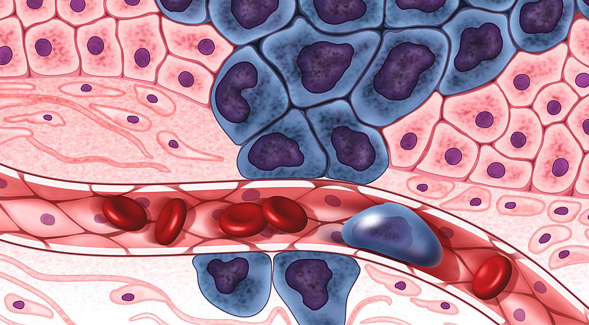Insights on Metastatic Cancer and How Cells Migrate
SDSU and UC San Diego bioengineers pinpoint a key factor that allows cancer cells to spread. The finding could help discover a way to make them stay put.

A cancer diagnosis is a dreaded event, but finding out the cancer has spread to a different part of the body, which indicates it’s a late stage metastatic cancer, is exponentially scary and stressful.
A team of bioengineers at San Diego State University and the University of California San Diego have discovered an important mechanism that prompts cancer cells to break away from stiff tissues in a tumor and spread to softer tissue. This discovery could help inform research into future therapeutics to treat metastatic cancer.
SDSU graduate research assistant Benjamin Yeoman is part of the joint SDSU-UC San Diego doctoral program and worked in the labs of mentors Parag Katira (SDSU Department of Mechanical Engineering) and Adam Engler (UC San Diego Jacobs School of Engineering) during this key discovery.
The SDSU News Team spoke with Katira, Engler and Yeoman to discuss their work, which was published Mar. 9 in the journal Cell Reports.
How do typical cells behave and how are cancer cells different in how they migrate?
Engler: Cancer results from unintended growth of a tissue, and cancer metastasis is the spread of that tumor to other tissues via cell migration. Normally cells migrate to the stiffest region of a tissue, but in cancer along with a host of other processes, the opposite occurs: cells that form aggressive metastatic disease migrate towards the soft tissue, a process called adurotaxis.
Katira: It was unclear what causes the migration of metastatic cancer cells from the stiff tumor environment which most cells usually migrate towards, to the softer tissue around the tumor. In our study we found that this atypical behavior is specific to a small set of cancer cells from the overall population. Being able to isolate and study these cells associated with the aggressive outcome has helped us understand some key aspects of how and why these cells migrate.
Is this more prevalent with certain types of cancers?
Engler: The process of migrating from stiffer tumors to softer surrounding tissue appears consistent among many “epithelial” tumors, those that are not from the blood or brain but rather come from solid tissues where linings are important such as lung, gut, pancreas, and breast. There is no universal biological marker for a metastatic tumor cell, but we believe that the number of cells found within these epithelial tumors that have this behavior could provide prognostic information about a tumor and the patient’s health.
Yeoman: There is a surprising amount of genetic diversity among the different types of cancers, and even among the cells within a single tumor, which makes it difficult to develop a universal treatment for all types of cancer. Because of the specific biological niche that exists in solid tumors, cancer cells are required to migrate towards the softer healthy tissue to escape the primary tumor. Our research suggests that despite the unique mutations of these types of cancers, the ability to migrate in this way may be more universal. Much like how bats and birds are completely different species, yet they both use the same mechanics to fly.
What is the key discovery you made and how will this help advance therapeutics?
Katira: In order to move, cells generate forces to pull and push against their surroundings. Using mechanics and computer modeling, we were able to compute how strong these forces are and how long they last for different cell types and in different environments. Based on these calculations, we can predict how different cells would migrate in and across environments that were soft or stiff.
Engler: Our model suggested a possible mechanism for our observations: weakly adherent cells actually pull harder on their surrounding tissue, which seemed counterintuitive. It also suggested that these cells pull for longer against softer environments, using this as a mechanism to sense and move towards softer tissues. We were surprised to confirm this experimentally, but our data suggests that therapeutics which target contraction might keep migratory cells within the tumor where it can be surgically removed.
How did the microfluidic device you used help you confirm your discovery?
Engler: The patent-pending device helps us sort cancer cells based on their adhesion to their surroundings, which determines their ability to migrate. Just like Goldilocks, cell adhesion needs to be “just right.” Too strong gets cells stuck and they cannot move. Too weak means that cells break their bonds before generating the force to move. Yet if just weak enough to not get stuck but strong enough to pull on their surroundings, then the cells are able to sense their environment and migrate in one direction.
***This project was funded by grants from the National Science Foundation, National Institutes of Health and the Army Research Office.



